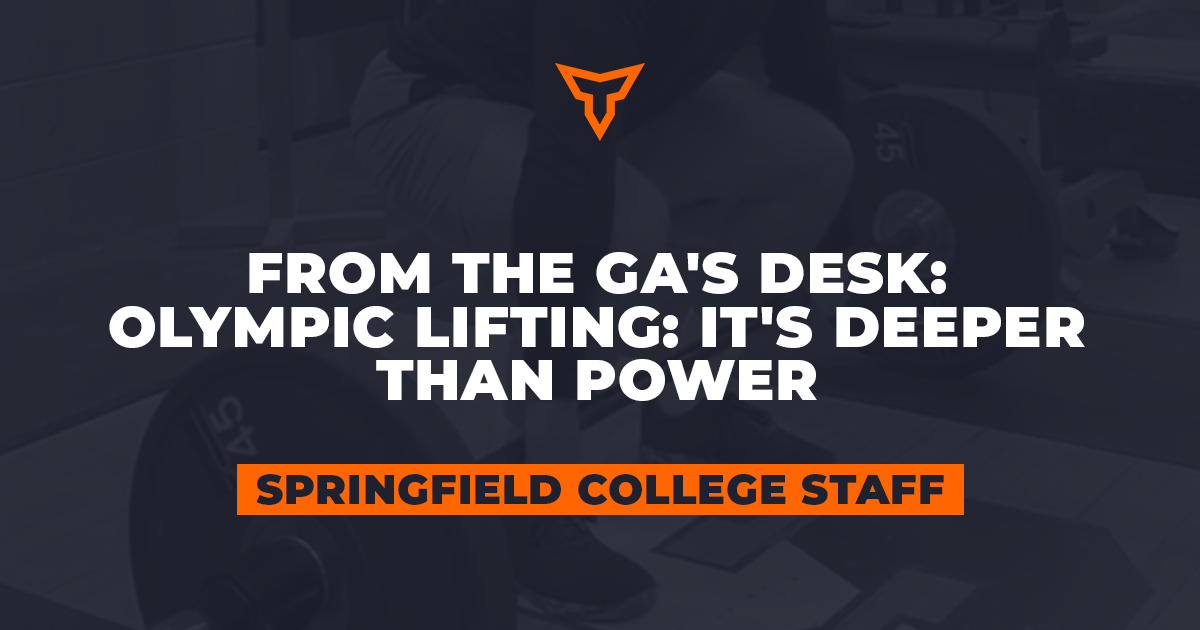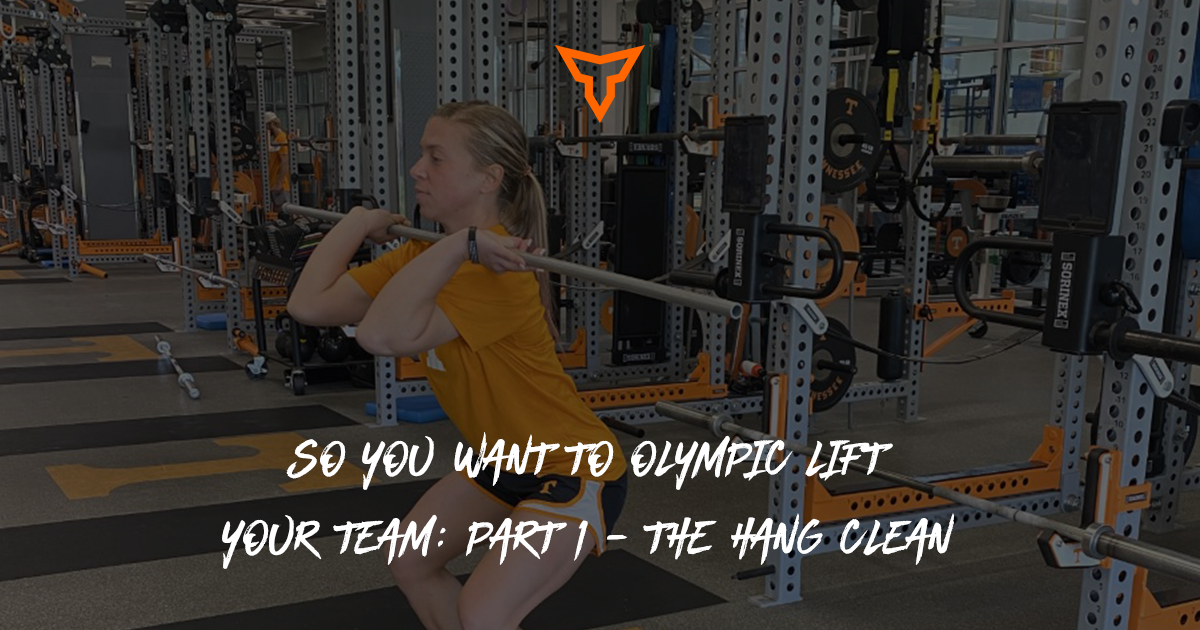Simplified 12-Week Intro to Olympic Weightlifting
Coach Dustin Dailey is currently the Director of Sport Performance for Wake Forest Women's Basketball.
Olympic weightlifting has performance benefits, plain and simple. Are there other ways to train? Of course. Is there an individual or population that shouldn’t perform Olympic weightlifting variations for performance? Again, of course. However, that does not mean that snatch, clean, and jerk variations are ineffective when used as performance-enhancement tools for athletes. So, let’s dive in.
Weightlifting movements take time to teach to be executed most effectively. Sometimes this is the primary reason coaches navigate away from programming/coaching them. and that is okay - your duty is to provide the best service to the population you are coaching. If Olympic lifts are not included in your program and you are getting the results you seek and expect - the program is working.
With that said, where would a coach start if they thought Olympic weightlifting variations could be beneficial when training their client(s) or team(s)? We’ll start at the top (pun intended) and outline 12 weeks to introduce the weightlifting variations. I will keep things short and sweet (no need to dive into position details, coaching cues, etc.).
Top-Down Approach - The Clean
The top-down approach is a well-known starting point for teaching and performing Olympic weightlifting movements as it breaks down the complexity of the movement into pieces from the end to the beginning. Let’s look at the clean for our primary example: the end of the movement includes a front-racked barbell in a squat position while the start may look similar to a deadlift with the barbell on the floor. From beginning to end, the process gives us the layout of our 12-week introductory program.
Table 1. The Top-Down Approach for the Clean.
|
Phase 0 |
Phase 1 |
Phase 2 |
Phase 3 |
|
|
Bar Position |
Front Rack |
Power Position |
Hang Position |
Floor |
|
Exercise |
Front Squat |
BB Power Jump/ Power Position Clean |
Clean Grip RDL/Hang Clean |
Clean Grip Deadlift/Clean |
Phase 0 serves as a checklist before beginning the clean - can the athlete properly front rack a barbell and perform a loaded front squat? Check. Now, we can move forward. In Phase 1, the bar sits at the power position (high thigh) in the clean exercise. A “power position power clean” is the shortest the bar will travel and, typically, the easiest for an athlete to understand. This is a foundational component of the full clean and a great exercise variation for non-weightlifting athletes. While the power position power clean gives live reps at the clean, we can layer a clean grip RDL as a primary exercise to introduce the bar position and motion of the hang power clean in the next phase. Below is a video summary of Phase 0 and Phase 1:
In Phase 2, the bar sits in the hang position (ideally, below the knee). Theoretically, the athlete understands the power position power clean and is strong in the clean grip RDL from Phase 1. The athlete will perform an RDL down into the hang position and execute a “hang below-knee power clean” as the new clean variation. You can insert pauses at the bottom of the RDL to reinforce the hang-below-knee position or at the top to reinforce the proper bar path into the power position. Again, we layer the clean grip deadlift as a primary exercise to develop pulling from the ground and to prepare for the full power clean in Phase 3. These two exercises are demonstrated in the video below for Phase 2:
Phase 3 is a power clean. The athlete should understand how to navigate the knee from the hang-below-knee power clean and the clean grip deadlift from the last phase. You can use pauses in the below-knee position to link the previous movement in the first few sessions of introducing the power clean (if appropriate). Phase 3 is demonstrated in the video below:
Top-Down Approach - The Snatch & Jerk
If you want to introduce the snatch or jerk, you would follow the same concept. For the snatch, establish a secure overhead position and the ability to perform a loaded overhead squat. Then, you would follow the same phase-by-phase breakdown (except with the snatch grip) to teach and train the snatch (see Table 2 and corresponding videos). For the jerk, execute a strict overhead or push press for a phase, and then add a push jerk on the last rep or two in the following phase. This should be set up doing just a jerk in the previous phase of training (see Table 3 and corresponding videos).
Table 2. The Top-Down Approach for the Snatch
|
Phase 0 |
Phase 1 |
Phase 2 |
Phase 3 |
|
|
Bar Position |
Overhead Rack |
Power Position |
Hang Position |
Floor |
|
Exercise |
Overhead |
BB Power Jump/ Power Position Snatch |
Snatch Grip RDL/Hang Snatch |
Snatch Grip Deadlift/Snatch |
Table 3. The jerk in phases
|
Phase 0 |
Phase 1 |
Phase 2 |
Phase 3 |
|
|
Jerk Variation |
Push Press |
Push Press + Push Jerk |
Push Jerk |
Floor |
Programming
Now that we have broken down the Olympic lifts into teachable and trainable elements, we can look at programming them. For this article, I am not diving into other program components, and I will solely focus on the top-down approach detailed above. If each phase was four weeks long, you are considering a 12-week program to introduce the Olympic lifts.
Table 4. Sample program for the cleaning in phases
|
Phase 1 |
Phase 2 |
Phase 3 |
|
|
Clean Variation |
Power Position Clean |
Hang Clean |
Full Clean |
|
Strength A |
Front Squat |
Front Squat |
Front Squat |
|
Strength B |
Clean Grip RDL |
Clean Grip Deadlift |
Table 5. Sample program for the snatch in phases
|
Phase 1 |
Phase 2 |
Phase 3 |
|
|
Snatch Variation |
Power Position Snatch |
Hang Snatch |
Full Snatch |
|
Strength A |
Overhead Squat |
Overhead Squat |
Overhead Squat |
|
Strength B |
Snatch Grip RDL |
Snatch Grip Deadlift |
“Strength A” is the respective squatting variation and is usually constant when introducing or training Olympic variants. “Strength B” is the respective pulling variation and can vary based on the comprehension of the Olympic lift. For example, suppose your population fails to grasp navigating the knee from the ground for a clean variation. In that case, you can continue to train the deadlift while doing a hang clean variation (repeat Phase 2 instead of progressing to Phase 3).
Lastly, I want to touch on the power clean/snatch versus the “squat” clean/snatch. I would highlight that if you were training non-weightlifters, there is no inherent need to “squat” clean/snatch. What purpose does the Olympic variation serve in your program? For most, it would be power development of some sort, so does a “squat” variation meet that intended purpose more than power variation? That is up to you to decide as the coach. I do not program non-weightlifting athletes to “squat” cleans/snatches. Still, suppose they are proficient enough in the Olympic lifts to perform a challenging power. In that case, they may catch the bar below parallel and naturally turn it into a “squat” variation. This is why the demonstration videos are a power clean/snatch.
I hope you found this article helpful if you want to introduce the Olympic movements to your population. This is a basic outline of exercises to implement to assist your coaching. Allow your program to develop the skill acquisition of the weightlifting movements.
Train safe, train smart, train effectively.
Subscribe to our blog
Subscribe to receive the latest blog posts to your inbox every week.
Related posts

From the GA's Desk: Olympic Lifting: It's Deeper than Power

Modifying the Conjugate Method for Tactical Athletes

